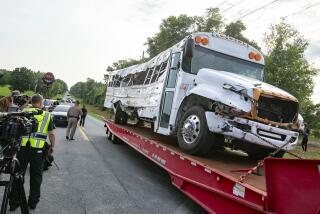Weller Deliberations Resume
- Share via
As jurors begin their first full day of deliberations today in the Santa Monica Farmers’ Market trial, they face an unusual twist: Key law enforcement officers testified for the defense of George Weller, the 89-year-old charged with manslaughter in the deaths of 10 shoppers.
Two top California Highway Patrol accident investigators told jurors that Weller plowed his car into the open-air market, also injuring 68, as a result of pedal error, a mistake in which the driver mistakes the accelerator for the brake.
Asked when he left court why Weller was on trial for a crime, Tom Shelton, formerly the CHP’s top expert who literally wrote the book on accident reconstruction, answered: “I’ve been asking that question since the beginning.”
Based on the same CHP report that the investigators cited, Los Angeles County Dist. Atty. Steve Cooley came to the opposite conclusion. His office decided Weller was criminally negligent, and charged him with 10 counts that could place him in prison for 18 years.
But D.O. “Spike” Helmick, CHP commissioner at the time of the farmers market crash, also told The Times he doubts that Weller committed a crime.
“I am inclined more toward viewing this as a terrible accident,” Helmick said in an interview.
“Victims have every right to have their redress. But you’ll never bring them back,” Helmick said. “I clearly think this gentleman wasn’t out doing these kind of things, like drinking or racing. Age caught up with him.”
Prosecutors declined to comment on the case with the jury out. But the three-week trial made it obvious that one of the biggest hurdles Deputy Dist. Atty. Ann Ambrose encountered was of the CHP’s making.
Ambrose argued eloquently that Weller was grossly negligent, citing witnesses who reported that he never braked, repeatedly revved his engine and steered to avoid parked vehicles as he was plowing into dozens of pedestrians along the length of the market, more than 700 feet.
But the fact that Weller’s case lacked an obvious marker of negligence, such as drinking, has created a special burden for prosecutors.
Jurors may be puzzled as they consider the testimony of Donald Karol, who headed the CHP investigative team that looked into the accident. The former sergeant, with 2,600 accident investigations under his belt, first concluded that the possibility of pedal error could not be ruled out.
His final review, Karol testified in Los Angeles County Superior Court, strengthened his original conclusion, identifying pedal error as “the best explanation” for the accident. Federal safety investigators eventually reached the same conclusion.
Shelton taught accident reconstruction at the CHP academy to Richard Wong, the only active CHP officer called by the prosecution. Wong testified that he, too, concurred that pedal error was the cause.
As defense attorney Mark Overland summarized his case for jurors last week, he heavily emphasized the testimony of all three CHP experts -- plus two academic experts who bolstered the case for pedal error.
“He was trying to stop the car. He wasn’t trying to hit people. The acceleration was unintended. That’s what everyone concluded,” Overland said.
Weller was described by witnesses as “focusing ahead, rigid, stern-looking, a very rigid, mannequin-like way,” according to Overland -- the hallmarks of panic so deep that the driver is incapable of correcting his fatal mistake of confusing the gas pedal with the brake.
Ambrose relied largely on eyewitnesses in the market, who said Weller appeared to control the car as he drove. She emphasized his comment -- reported by two witnesses but sharply contested by the defense -- that the pedestrians should have “gotten out of the way.” Others testified that after his car came to a rest, Weller at first refused to get out or give up the car keys, undercutting the defense’s panic claim.
Jurors also must sort out the inherently vague legal concept of criminal negligence. Gross negligence can mean conscious indifference to a risk of harm to others.
Lawyers say it is an objective standard, meaning jurors don’t have to intuit what Weller was thinking, but decide whether he drove the way a reasonable person would under similar circumstances.
The defense strongly opposed instructing jurors that they could find manslaughter based on a lesser standard of common negligence. The prosecution did not oppose the defense’s position.
But the judge himself, Michael Johnson, intervened to give jurors the common negligence option. Some observers say manslaughter with simple negligence might emerge as a compromise verdict for jurors caught between sympathy for Weller and the grim reality of the 10 people who died.
Helmick, the former CHP commissioner, suggested the case should never have gone to trial, particularly as it’s unlikely that Weller would be sentenced to prison, even if convicted, because of his advanced age.
The “ideal resolution,” Helmick said, would have been a guilty plea by Weller in a deal that kept him out of incarceration. “This is a man who made a tragic mistake.” Helmick said. “It’s going to be tough for a jury to decide on the best punishment.”
*
More to Read
Sign up for Essential California
The most important California stories and recommendations in your inbox every morning.
You may occasionally receive promotional content from the Los Angeles Times.












